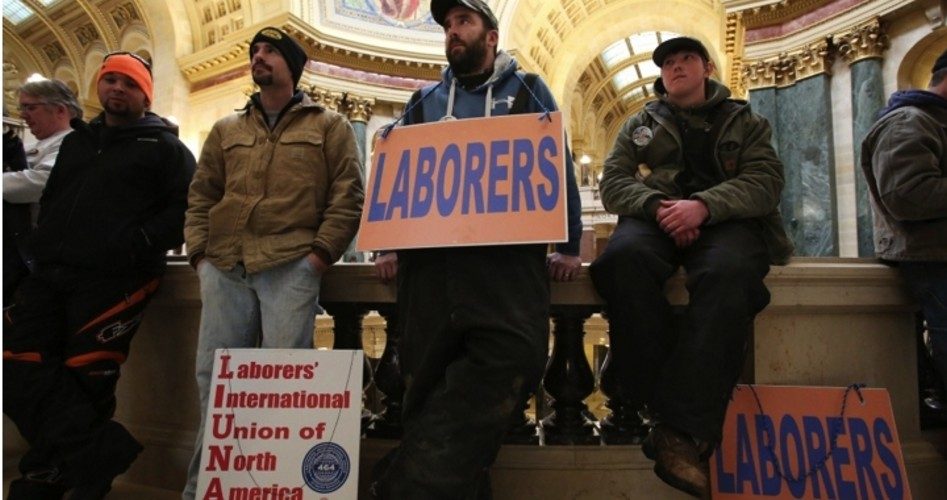
The last time Wisconsin unions were threatened, tens of thousands of union members showed up at the state house, disrupting the legislative process and garnering headlines across the nation. This week scarcely 2,000 (a generous estimate from the New York Times) bothered to protest the right-to-work vote that passed the state Senate.
Scarcely three weeks into his first term, Wisconsin Governor Scott Walker presented his “Wisconsin Budget Repair Bill” to close the $362-million deficit left behind by his predecessor, Democrat Jim Doyle. Included in that bill was language reducing union bargaining power over pay and benefits, and increasing the amount union members must pay for those benefits.
Once the dust had settled, Walker emerged temporarily scarred but victorious. The unions instigated a recall campaign from which Walker again emerged the winner, over the same opponent he defeated in 2010.
Now Walker, having proved his survival skills in a state that voted for President Obama in both 2008 and 2012, has launched his campaign for the presidency in 2016 with the creation of a political action committee called “Our American Revival.” As part of that campaign, he was advised not to follow through on calls to face off with unions again with a right-to-work bill because it would be a distraction to his continuing efforts to revive Wisconsin’s moribund economy — especially since he had just announced budget cuts to the University of Wisconsin, along with suggestions that the professors there work a little harder.
But savvy politicians, according to one of his advisors, Lance Tarrance, sense when the wind is blowing favorably, and when momentum behind right-to-work (removing union rules that required non-union members to pay union dues) began to build, Walker announced that if Republicans could get such a bill to his desk, he would sign it. A Walker spokesman said, “Governor Walker continues to focus on budget priorities to grow our economy and to streamline state government. With that said, Governor Walker … supports this policy. If this bill makes it to his desk, Governor Walker will sign it into law.”
Wisconsin is enjoying an economic rebound, as it has experienced back-to-back surpluses in the last two years under Walker, and unemployment has dropped from more than nine percent in 2011 to six percent in 2013, reflecting the more than 100,000 new jobs added to the economy since Walker’s arrival.
Tarrance, the founder of a high-profile political action group, wrote in his 2013 book How Republicans Can Win in a Changing America about the 15 key characteristics a successful candidate must possess in order to win in 2016. Among them, Tarrance noted, he must have courage. Accordingly, Walker wrote (or had written for him) a history of the union challenges to his program, called Unintimidated, in which he described the struggles, challenges, and even the threats he endured while dismantling important parts of the union structure in Wisconsin.
According to Tarrance, a successful candidate must also have a proven track record as a manager of a large enterprise: check for Governor Walker. He must have an identifiable political ideology: check. He must learn from his mistakes: check. He must have a sense of humor in the face of challenges: check. He must be married and faithful: check. He must know the words to the National Anthem and the Pledge of Allegiance: check. And he must have strong spiritual and moral convictions: check and check.
Walker used his 15-minute talk at the Conservative Political Action Conference (CPAC) near Washington, D.C., this week to regale his audience with a listing of his accomplishments. When a heckler interrupted him, Walker — without missing a beat — told his audience that the heckler must have been a union protester who followed him from Wisconsin, adding, “Those voices can’t drown out the voices of hard-working taxpayers!” He received thunderous applause from the partisan crowd. To make the point, and once again seize the opportunity presented at that moment, Walker told his audience that if he “can take on 100,000 protesters,” he certainly would be up to the domestic and foreign policy challenges of the presidency.
His support for right-to-work legislation in Wisconsin couldn’t come at a better time. Union membership has fallen from one-third of all private-sector workers in 1954 to barely 11 percent, and Gallup shows overwhelming support for such laws by more than four to one. Studies have shown that states with right-to-work laws have stronger economies and lower unemployment rates than those without. One such study by Illinois Policy (an independent government watchdog) showed that Illinois, a southern neighbor to Wisconsin without right-to-work legislation, “suffered a net loss of $35.3 billion in tax revenue [between 1995 and 2010], due to a net out-migration of 855,196 people.” It added:
From 2002 to 2012 the economies of Right-to-Work states grew by a total of 62 percent, compared to only 46.5 percent in non-Right-to-Work states.
Illinois’ economy has been particularly sluggish, growing by a total of only 36.9 percent.
At the moment, Walker appears to be riding a wave of success, both economic and political. Once the right-to-work bill passes Wisconsin’s Assembly next week and he signs it into law, Wisconsin will join 24 other states with such legislation, and Walker will take one more giant step toward the White House in 2016.
A graduate of an Ivy League school and a former investment advisor, Bob is a regular contributor to The New American magazine and blogs frequently at www.LightFromTheRight.com, primarily on economics and politics. He can be reached at [email protected].
Related article:
Wisconsin Governor Walker to Substantially Reduce University Spending

